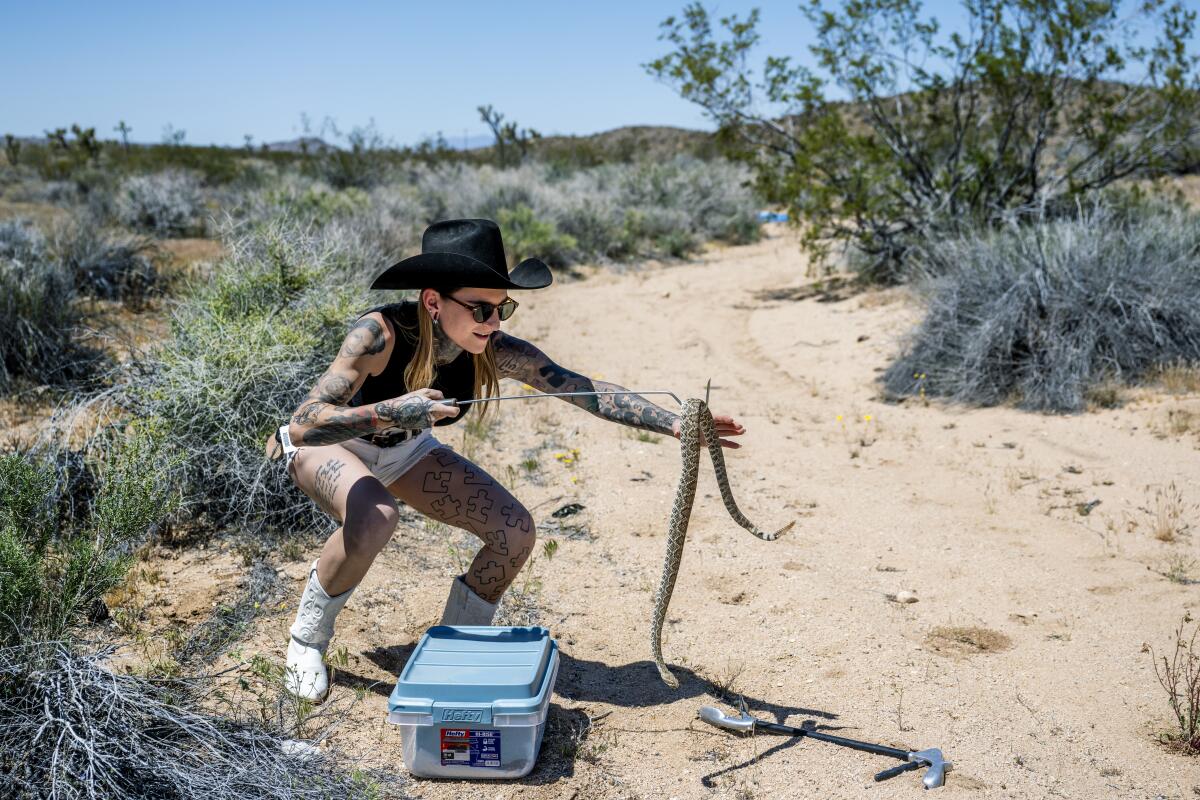The desert is gentrifying. This snake wrangler has a front-row view
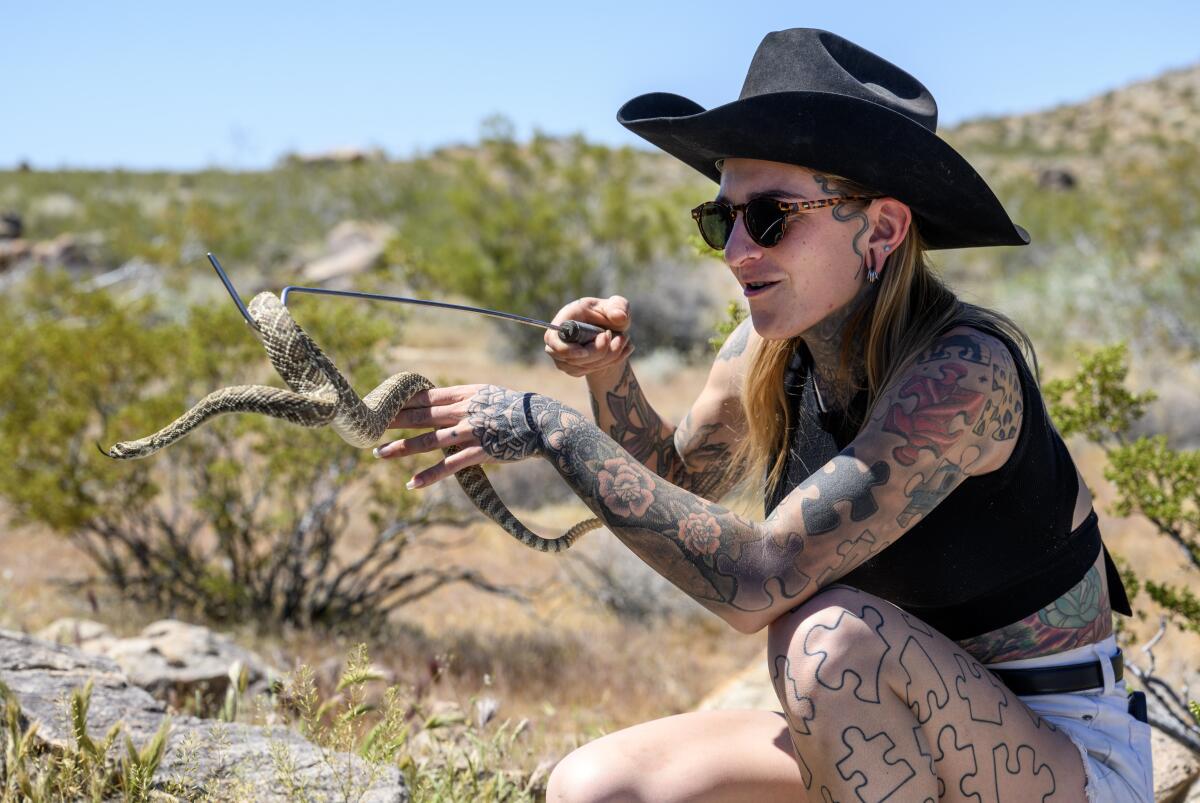
- Share via
Good morning. It’s Monday, May 6. I’m Alex Wigglesworth, an environment reporter for The Times. Here’s what you need to know to start your day.
- The desert is gentrifying — and a famous snake wrangler has a front-row view.
- LAPD officers cleared out USC’s pro-Palestinian encampment Sunday morning.
- Our ocean noise pollution is harming marine life, a new study reveals.
- And here’s today’s e-newspaper.
You're reading the Essential California newsletter
Our reporters guide you through our biggest news, features and recommendations every morning
You may occasionally receive promotional content from the Los Angeles Times.
A snake wrangler’s view of gentrification in the California desert
When I first reached out to Danielle Wall, I was hoping to learn about rattlesnakes. The snake wrangler has become a celebrity in California’s high desert, and I wanted to tag along on some calls and check out her work.
But it turns out that her job is enlightening not just about rattlers but also their shrinking habitat and the humans who have been shaking it up.
The communities surrounding Joshua Tree National Park have been rocked by transformative changes since the COVID-19 pandemic sent hordes of city dwellers into more isolated areas. (Full disclosure: I was one of them, exchanging my Inglewood one-bedroom for a 7.5-acre spread for roughly the same monthly price.)
Some, like me, became full-time residents; others flipped properties or converted them to vacation rentals. Home prices skyrocketed.
As someone who humanely relocates rattlesnakes that people find on their properties, Wall has seen these shifts from a unique vantage point. I realized this as I followed her on her eighth call of the day, to yet another home that was being renovated.
Just look at Landers, where Wall lives. Between 2020 and 2022, the unincorporated community north of Yucca Valley — historically known as a meeting spot for UFO enthusiasts — saw the biggest jump in typical home values of anywhere in California, according to the San Francisco Chronicle. It was followed by the nearby towns of Joshua Tree and Twentynine Palms.
There were, of course, beneficiaries. For instance, Wall sold her home for a profit, using the proceeds to purchase her great-grandparents’ larger property. That investment has essentially underwritten her snake-wrangling services. The donations she collects are not sufficient to cover her expenses.
But many locals were pushed out entirely, especially those who rented. The people who have replaced them sometimes appear to be better off financially and yet less willing to contribute to the community, said Wall, who for a time contemplated charging short-term rentals for her services before realizing it wasn’t legal to do so.
She’s unable to charge anyone since she’s prohibited by state law from operating as a business and lacks nonprofit status. That means she relies on donations (which aren’t tax deductible) to continue her work.
“Those ended up being the people who didn’t want to even donate $5 for gas; who were rude, didn’t care,” said Wall from the front porch of her home, which sits on a dirt road that dead-ends into a semicircle of rocky mountains.
Wall’s view is not limited to how demographic shifts have affected the human residents of this slice of the Mojave Desert. She’s watched in real time as the same changes have wreaked havoc on the local wildlife — including an increase in rodent poison that’s killing birds of prey, and an uptick in trash that’s attracted more ravens, which feed on the young of desert tortoises. And, of course, humans’ burning of fossil fuels has ratcheted up temperatures worldwide, making this infamously hot and dry place even hotter and drier.
All this raises hard questions. Is the presence of humans, and the changes they’ve recently wrought, hurting the very things that people seek to enjoy about the desert — its wildlife and beauty? And how can we be better neighbors?
The answer isn’t that hard, Wall says: Simply focus on improving your little corner.
“I save what I can,” she said, “and I tell people to save what they can.”
You can read more about Wall in my Times subscriber exclusive story.
Today’s top stories
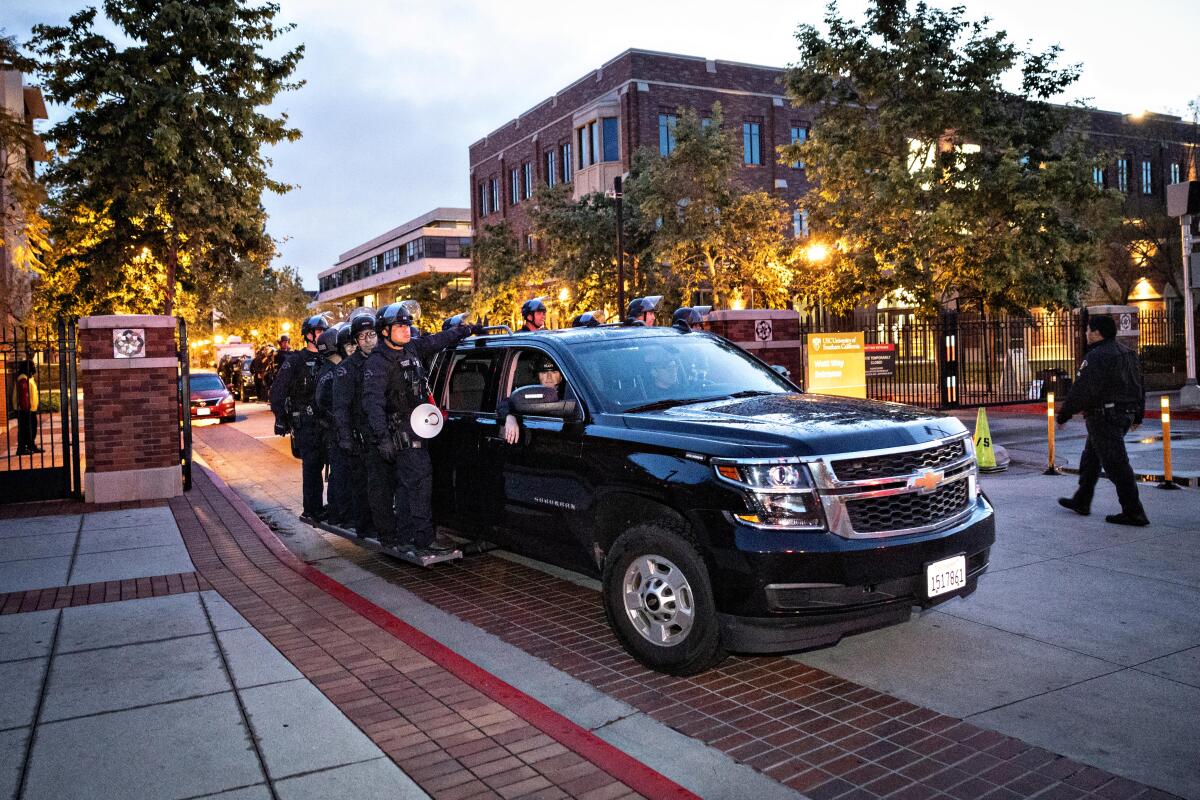
Pro-Palestinian protests on campus
- Police removed tents and cleared USC’s pro-Palestinian encampment Sunday, but no arrests were made.
- UCLA has created a high-level post to oversee campus safety after security lapses that occurred when protesters were attacked.
- UCLA faculty protested at the Hammer Museum gala, decrying the treatment of pro-Palestinian students
More on campus protests
- It’s been 55 years since California’s then-Gov. Ronald Reagan took on Berkeley over Vietnam War demonstrations. Now-Gov. Gavin Newsom is taking more of a linger-in-the-background approach.
- Metal detectors, fear and frustration. Here’s how college commencements are being altered amid Gaza war protests.
- For two young journalists, the showdown at UCLA’s camp was baptism by fire
George Gascón’s reelection efforts
- Felony charges against L.A. County Dist. Atty. Gascón’s top advisor have sparked confusion and criticism.
- The high-ranking L.A. prosecutor was booked in April, and released on $50,000 bond.
- George Gascón survived the primary. Can Nathan Hochman unseat him as D.A.?
Crime and public safety
- Seven people were injured, four critically, in a shooting near a nightclub in Long Beach on Saturday night.
- Amid a spike in school crime, a task force says L.A. campuses should be allowed to decide whether they need police stationed on campus.
- A driver was killed after his SUV slammed into a South L.A. church.
More big stories
- The California supreme court will hear arguments battle over the legality of an initiative that would restrict the governor and legislature from increasing taxes.
- A superintendent was fired after allegedly investigating students for not applauding her daughter enough.
- After years of partisan feuding, California’s new generation of Congress members tries to get along. Will it work?
Get unlimited access to the Los Angeles Times. Subscribe here.
Commentary and opinions
- Doyle McManus: Donald Trump puts America on notice again: If he loses, he won’t go quietly.
- Gustavo Arellano: Pringles, plywood and chalk. Here’s the supply chain sustaining the Cal State L.A. encampment.
- Robin Abcarian: Don’t denigrate pro-Palestinian campus protests by claiming the Vietnam War protests backfired.
- Editorial: L.A. Metro is doomed if it can’t keep bus and train riders safe.
- Jackie Calmes: Donald Trump’s terrible, horrible, no good, very bad second term.
- Editorial: Break out the hook. This time the Trump-Biden debates need tight rules of civility.
Today’s great reads
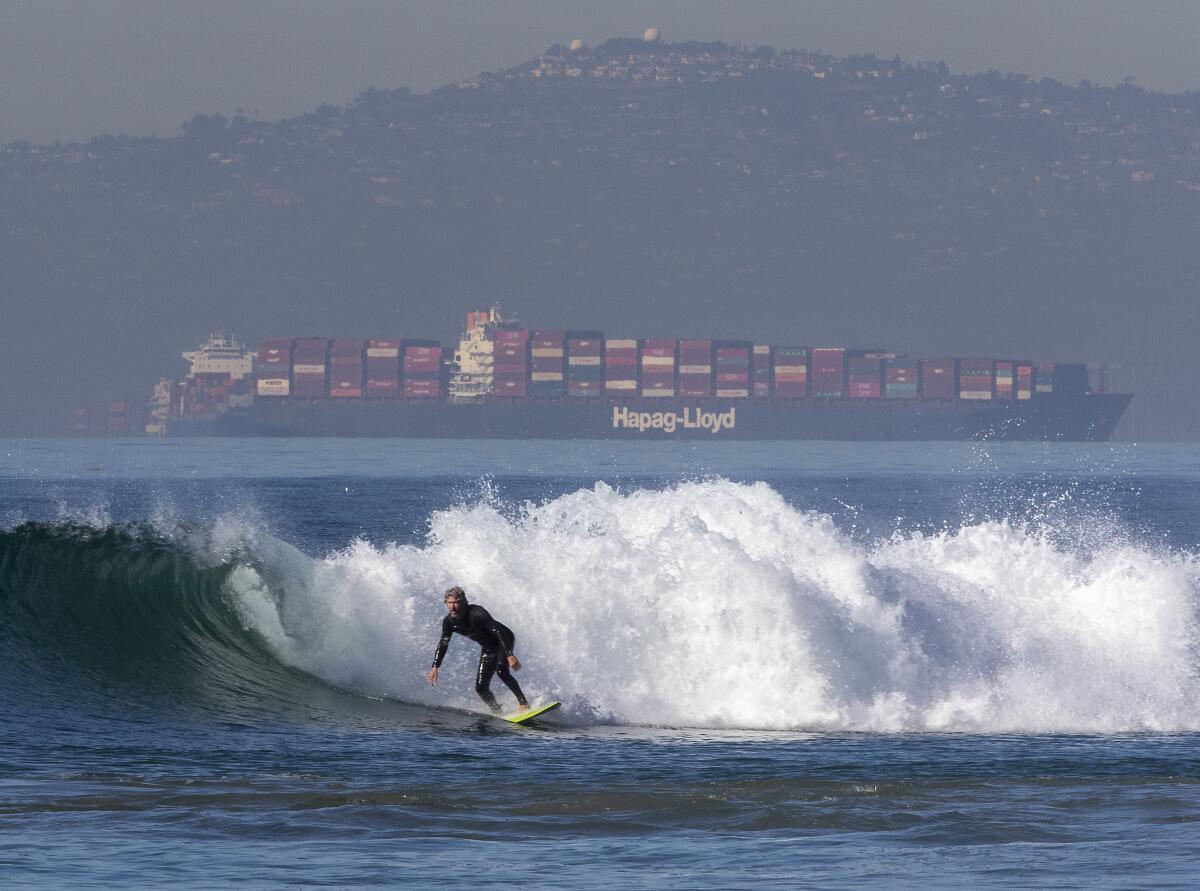
We’ve been making quite a racket in our oceans. A new study shows how that’s harming whales and other marine animals. While few land dwellers have given much thought to this shift in ambient marine noise, new research has modeled, for the first time, how the Industrial Revolution and the advent of commercial shipping have turned up the volume in the waters off Los Angeles. Hear the difference for yourself.
More great reads
- L.A. influencers and businesses live or die on TikTok’s algorithm. Now they fear for the future
- We strapped in with director George Miller, the ‘Mad Max’ mastermind, back with ‘Furiosa.’ Here’s what he had to say.
How can we make this newsletter more useful? Send comments to [email protected].
For your downtime
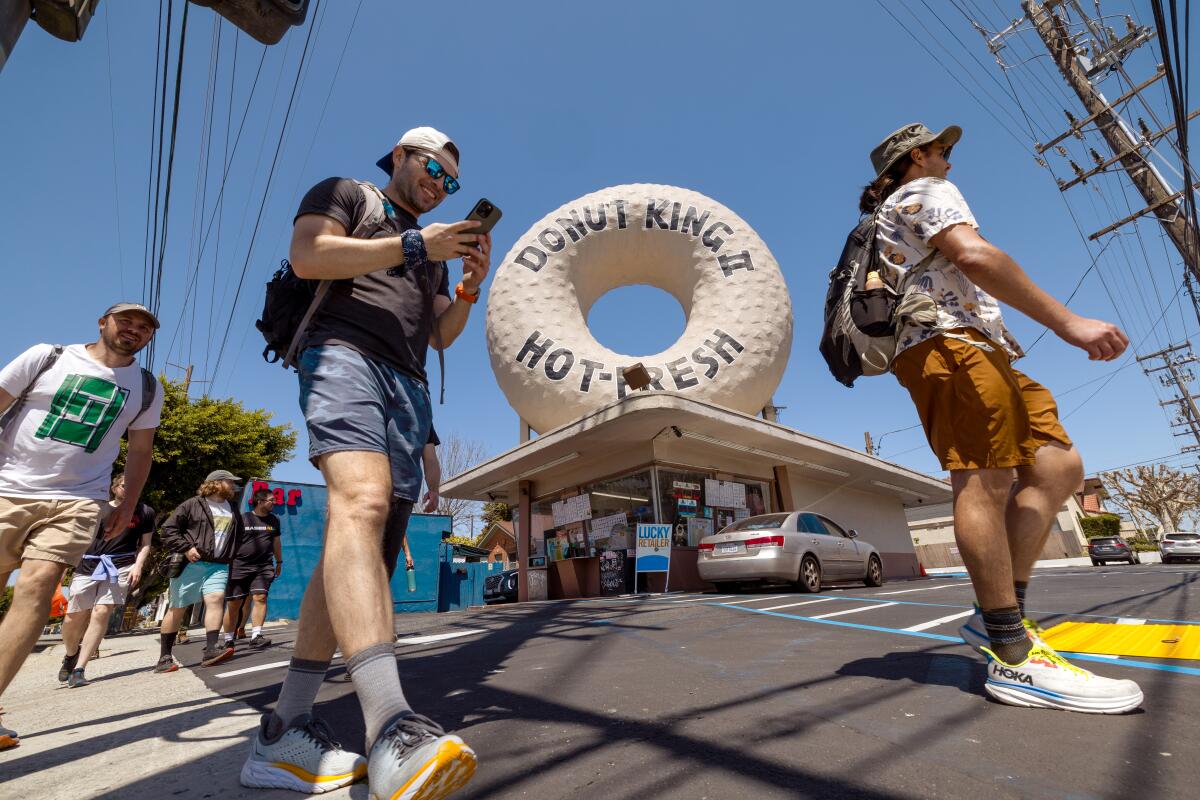
Going out
- 🍔 Looking for your new favorite cheeseburger? Times food columnist Jenn Harris says you’ll find it in Redlands.
- 👟 If you want more of a challenge to your daily walk, check out this 28-mile route from Griffith Park to San Pedro (or just walk vicariously, through this story).
- 🤣 Netflix Is a Joke Fest continues through May 11. Here’s a list of must-see shows.
Staying in
- 📖 Contributor Sarah Fay reviews Ernesto Londoño’s memoir “Trippy,” which explores psychiatry’s renewed flirtation with drugs such as LSD.
- 🧑🍳 Here’s a 40-minute recipe for pita bread.
- ✏️ Get our free daily crossword puzzle, sudoku, word search and arcade games.
And finally ... a great photo
Show us your favorite place in California! We’re running low on submissions. Send us photos that scream California and we may feature them in an edition of Essential California.
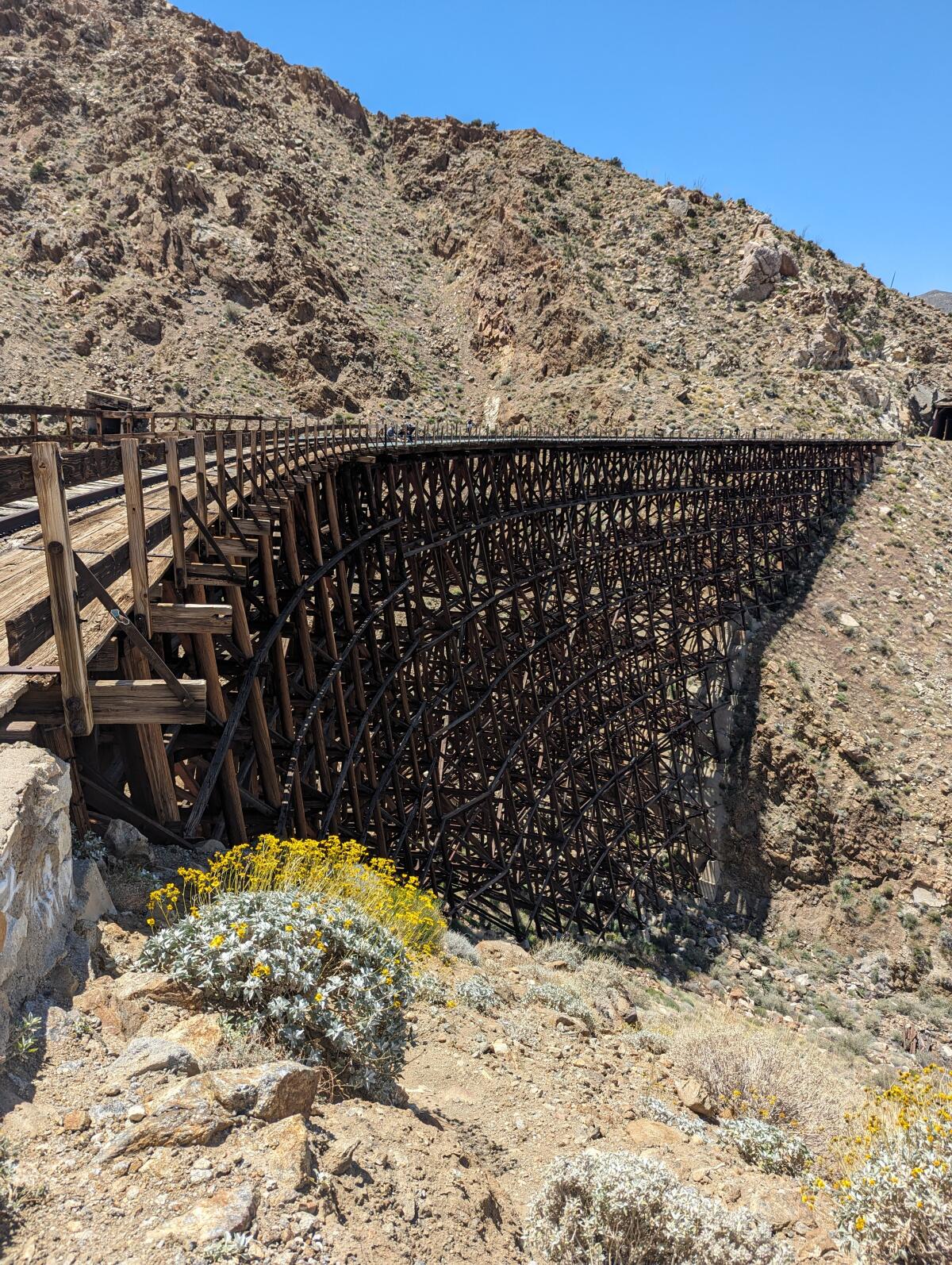
Today’s great photo is from Lee Friedersdorf of Costa Mesa: the record-holding Goat Canyon Trestle in Anza Borrego State Park. Lee writes:
“It’s the world’s largest all-wood trestle. It was built in 1933 as part of the San Diego and Arizona Eastern Railway, after one of the many tunnels through the Carrizo Gorge collapsed.”
Have a great day, from the Essential California team
Ryan Fonseca, reporter
Amy Hubbard, deputy editor, Fast Break
Check our top stories, topics and the latest articles on latimes.com.
Sign up for Essential California
The most important California stories and recommendations in your inbox every morning.
You may occasionally receive promotional content from the Los Angeles Times.
